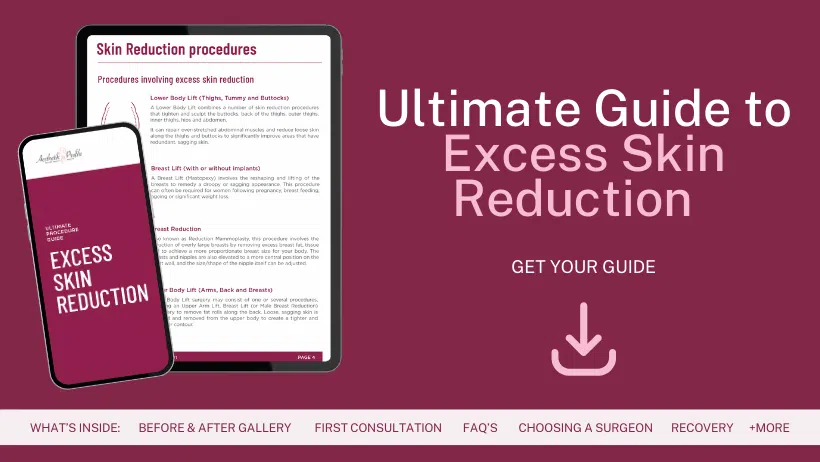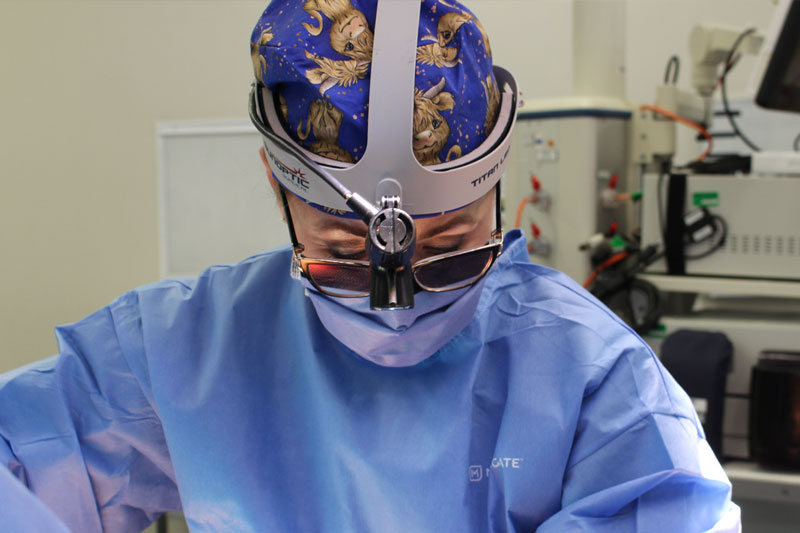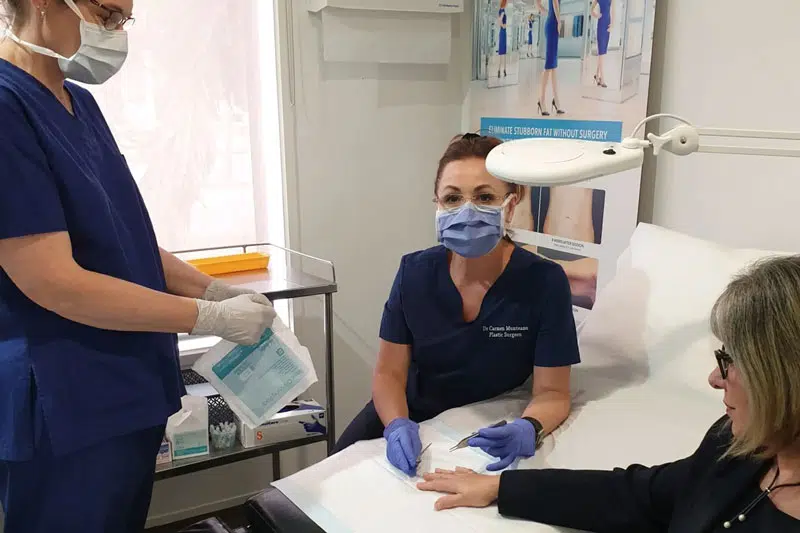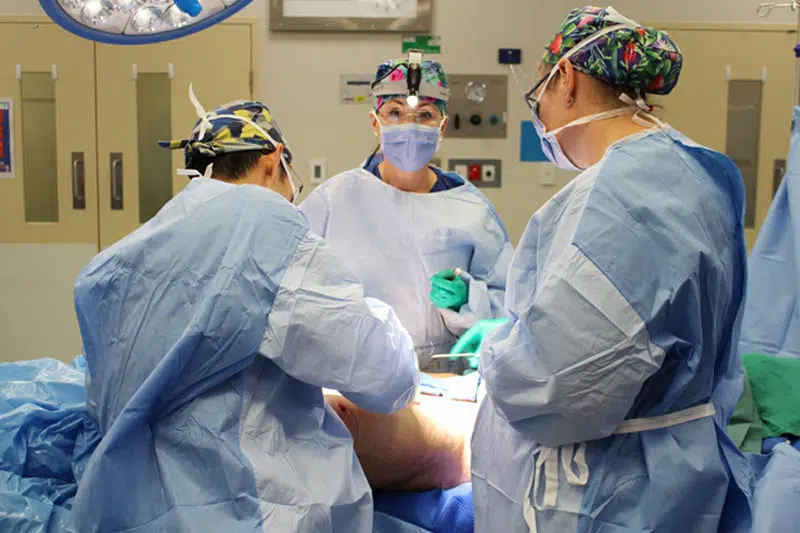Reshaping the Abdomen through Excess Skin and Fat Removal
A loose tummy refers to the excess skin and fat that accumulates around the abdomen. It can be a result of stretched abdominal muscles, weakened connective tissues, or the accumulation of adipose tissue. The presence of a loose tummy can lead to physical discomfort. Apronectomy, or loose tummy surgery, is a surgical procedure designed to remove excess skin and fat from the lower abdomen, which may help create a flatter appearance of the lower abdomen, depending on individual healing and anatomical factors. This procedure specifically targets the apron of excess skin that hangs down over the abdomen, often caused by significant weight loss, pregnancy, or genetics. Apronectomy is a procedure that may be considered for patients with significant excess skin and fat in the lower abdomen, particularly after weight loss or pregnancy.
Dr Carmen Munteanu is a Specialist Plastic Surgeon regularly performing post weight loss surgery and post-pregnancy surgery in Melbourne, Australia.
Take our Plastic Surgery Quiz to find out if you’d be a good candidate and if you are ready for cosmetic surgery.
Causes of a Loose Tummy
A loose tummy can have various causes, and understanding these factors is crucial in addressing the issue effectively. Here are some common causes of a loose tummy:
- Pregnancy: A loose tummy can be caused by pregnancy. During pregnancy, the abdominal muscles and skin stretch to accommodate the growing fetus. After childbirth, the abdominal area may not fully retract, leaving behind loose skin and weakened muscles. How many times you were pregnant and the size of the baby can also contribute to the severity of a loose tummy
- Significant weight loss: Losing a considerable amount of weight can lead to a loose tummy. When you lose weight rapidly, the skin may not retract to the new body shape. As a result, the skin may become loose and saggy, especially in the abdominal area. This is particularly common in cases of weight loss after bariatric surgery or through rigorous diet and exercise
- Ageing: With the natural ageing process, the skin loses its elasticity and natural collagen production decreases. This loss of elasticity can result in sagging skin, including in the abdominal area. Additionally, the underlying muscles may weaken with age, leading to a loss of abdominal tone and contributing to a loose tummy
- Genetics: Some people may be genetically predisposed to having a loose tummy. Genetic factors can influence the quality and elasticity of the skin, as well as the strength of the abdominal muscles. Even with a healthy lifestyle and proper weight management, some people may still experience a loose tummy due to their genetic makeup
- Lifestyle factors: Certain lifestyle choices can also contribute to a loose tummy. Lack of exercise and sedentary behavior can weaken the abdominal muscles, leading to poor muscle tone and a loose appearance. More than this, poor nutrition and a diet high in processed foods and sugary drinks can contribute to weight gain and the accumulation of excess fat in the abdominal area
Why to Choose Apronectomy Over A Full Abdominoplasty?
If you are considering whether to choose apronectomy over a full abdominoplasty (traditional tummy tuck), it is important to understand the key differences between the two procedures and the factors that may influence your decision. Here are a few reasons why you might opt for an apronectomy:
- Targeted approach: Apronectomy specifically focuses on removing the apron of excess skin and fat in the lower abdomen. It is a more localised procedure that addresses the area of concern without involving muscle tightening. If your main concern is the apron of tissue hanging over your abdomen, apronectomy provides a targeted solution
- Less extensive surgery: Compared to a full abdominoplasty, apronectomy is generally considered a less extensive surgical procedure. It involves a smaller incision and has a shorter recovery period. If you prefer a less invasive option or have specific limitations or concerns regarding a more extensive surgery, apronectomy may be a suitable choice
- Faster recovery: Due to its less extensive nature, apronectomy often involves a quicker recovery time compared to a full abdominoplasty. This can be a plus if you have a busy lifestyle or limited time for recovery and want to return to your normal activities sooner
- Individual circumstances: Your individual circumstances and the specific characteristics of your abdomen play a significant role in determining the most appropriate procedure. If you have minimal muscle separation, good muscle tone, and the main concern is excess skin and fat in the lower abdomen, apronectomy might be recommended
Differences Between Abdominoplasty And Apronectomy
Abdominoplasty and apronectomy are both surgical procedures aimed at addressing excess skin and fat in the abdominal area. While they have similarities, there are key differences between the two procedures. Here is a breakdown of the main distinctions:
1. Extent of surgery: Abdominoplasty, commonly known as a tummy tuck, is a more extensive procedure compared to apronectomy. It involves not only the removal of excess skin and fat but also the tightening of abdominal muscles. Abdominoplasty is designed to address both the upper and lower abdomen, whereas apronectomy specifically focuses on the apron of excess tissue in the lower abdomen
2. Muscle tightening: A significant difference between abdominoplasty and apronectomy is the inclusion of muscle tightening in abdominoplasty. During abdominoplasty, Dr Carmen sutures the underlying abdominal muscles to create a firmer and more defined abdominal wall. Apronectomy, on the other hand, does not involve muscle tightening and primarily focuses on the removal of excess skin and fat
3. Scarring: The incision and resulting scar patterns differ between abdominoplasty and apronectomy. In a full abdominoplasty, the incision is often made from hip to hip, and a second incision may be made around the belly button. This allows for the repositioning of the belly button and the removal of a larger amount of skin and fat. In apronectomy, the incision is usually limited to the lower abdomen, and it may be shorter in length compared to a full abdominoplasty. The resulting scar is usually lower on the abdomen in apronectomy
4. Recovery and results: Due to the extent of the surgery, the recovery period for abdominoplasty is usually longer compared to apronectomy. It may take several weeks for full recovery from a tummy tuck/ abdominoplasty, whereas apronectomy may have a shorter recovery time. The results of both procedures can be significant, providing a flatter and more contoured abdominal appearance. However, due to the additional muscle tightening, abdominoplasty may offer more comprehensive abdominal shaping and toning.
Is Apronectomy the Right Choice?
Apronectomy can be the appropriate option for patients who have experienced significant weight loss and are left with loose, sagging skin that affects their comfort. It can also benefit women who have gone through multiple pregnancies and have excess abdominal skin that diet and exercise alone cannot address. A good candidate for an apronectomy usually fulfills the following criteria:
- Body Mass Index (BMI): Your BMI should be 30 or less if you want to be healthy. A higher BMI can make it more dangerous to have surgery and could slow down the healing process
- Stable weight: You need to have kept the same weight for at least a year before the surgery. This is because a big change in weight after the surgery can affect the results of the procedure
The Benefits of Apronectomy
- Improved look: Apronectomy can remove excess skin and fat, which may improve the contour of the lower abdomen in some individuals. The process gets rid of the “apron” of extra skin and fat that hangs over the pubic area. This makes the abdomen smoother
- Enhanced mobility: By removing the apron of excess skin, apronectomy can improve your mobility and make physical activities more comfortable
- Better hygiene: The excess skin fold can lead to hygiene issues, such as skin irritation and infection. Apronectomy eliminates these problems, promoting better hygiene
- Back Pain Relief: Sometimes, the weight of the “apron” can cause pain in the lower back. By getting rid of this weight, some people may feel less discomfort in their backs
- Promotes an active lifestyle: By reducing excess tissue, some patients may find physical activity more comfortable. Maintaining results depends on lifestyle factors.
How Does Apronectomy Work?
An apronectomy is a surgical procedure that specifically targets the excess skin and fat in the lower abdomen, without involving the tightening of abdominal muscles as in a traditional tummy tuck/ abdominoplasty. The main goal of apronectomy is to remove the apron of tissue that hangs down over the abdomen, resulting in a flatter and firmer tummy.
During the apronectomy procedure, Dr Carmen will make an incision along the lower abdomen and carefully remove the excess skin and fat tissue. The remaining skin is then meticulously sutured back together to create a smoother, more toned appearance. This procedure focuses solely on addressing the apron of excess skin and does not involve muscle tightening.
The recovery process following an apronectomy is similar to that of other surgical procedures. It requires time and patience.
Download Dr Carmen’s Guide to Excess Skin Reduction Surgery

Risks and Complications of the Apronectomy Procedure
- Infection: While rare, there is a risk of developing an infection after apronectomy. This can be managed with proper care and the use of antibiotics if necessary
- Bleeding: Some patients may experience post-operative bleeding. This can be addressed by closely monitoring the surgical site and taking appropriate measures to control bleeding
- Adverse reactions to anaesthesia: Anaesthesia carries inherent risks. In rare cases, patients may experience adverse reactions or complications related to the administration of anaesthesia
- Poor wound healing: In some instances, the incision site may experience delayed or poor wound healing. Close monitoring, proper wound care, and following post-operative instructions can minimise this risk
- Scarring: Apronectomy involves incisions, which will result in scarring. Although efforts are made to minimise scarring, individual healing responses may vary. Dr Carmen will provide instructions on scar care
- Seroma formation: Seromas, the accumulation of fluid under the skin, can occur after apronectomy. These can be drained if necessary and managed with proper post-operative care
- Numbness or sensation changes: Temporary or permanent changes in sensation, such as numbness or hypersensitivity, may occur in the treated area. This often resolves over time but can persist in rare cases
- Delayed recovery or prolonged swelling: Each patient’s recovery process is unique, and some may experience delayed recovery or prolonged swelling. Adhering to post-operative guidelines and allowing sufficient time for healing can help alleviate these issues
- Asymmetry or irregularities: In some cases, minor asymmetry or irregularities in the abdominal contour may occur. Dr Carmen aims for symmetrical and smooth results, but individual healing responses may influence the final outcome
FAQs About Apronectomy
What is the difference between apronectomy and a tummy tuck/ abdominoplasty?
- An apronectomy focuses specifically on removing the excess skin and fat from the lower abdomen, whereas a tummy tuck, also known as abdominoplasty, involves tightening the abdominal muscles in addition to removing the excess tissue.
Will apronectomy remove my stretch marks?
- Apronectomy may result in the removal of some stretch marks if they are located on the excised skin. However, stretch marks above the belly button or on other areas of the body will remain.
Can I get pregnant after apronectomy?
- While it is possible to get pregnant after apronectomy, it is generally recommended to wait until you have completed your family before undergoing the procedure. Pregnancy following apronectomy can stretch the abdominal skin and potentially compromise the results.
What are the potential risks and complications of apronectomy?
- Like any surgical procedure, apronectomy carries some risks, including infection, bleeding, poor wound healing, scarring, and anaesthesia-related complications. It is essential to discuss these potential risks with Dr Carmen before making a decision.
How long do the results of apronectomy last?
- Results can be maintained long-term with a stable weight and healthy lifestyle, although individual experiences and outcomes vary. Significant weight fluctuations or subsequent pregnancies can affect the outcome.
Further Reading about Body Procedures with Dr Carmen
- Read Dr Carmen’s Liposuction Surgery Page
- Read Dr Carmen’s Thigh Lift Surgery Page
- Read Dr Carmen’s Tummy Tuck – Abdominoplasty Surgery Page
- Read Dr Carmen’s Blog about Recovery after Tummy Tuck/ Abdominoplasty – Tips, Timeline and FAQs
- Read Dr Carmen’s Fleur de Lis Abdominoplasty Surgery Page
Medical References about Abdominoplasty
- Tummy Tuck: Plastic Surgery – Cleveland Clinic
- Tummy tuck – Mayo Clinic
- Abdominoplasty – StatPearls – NCBI








